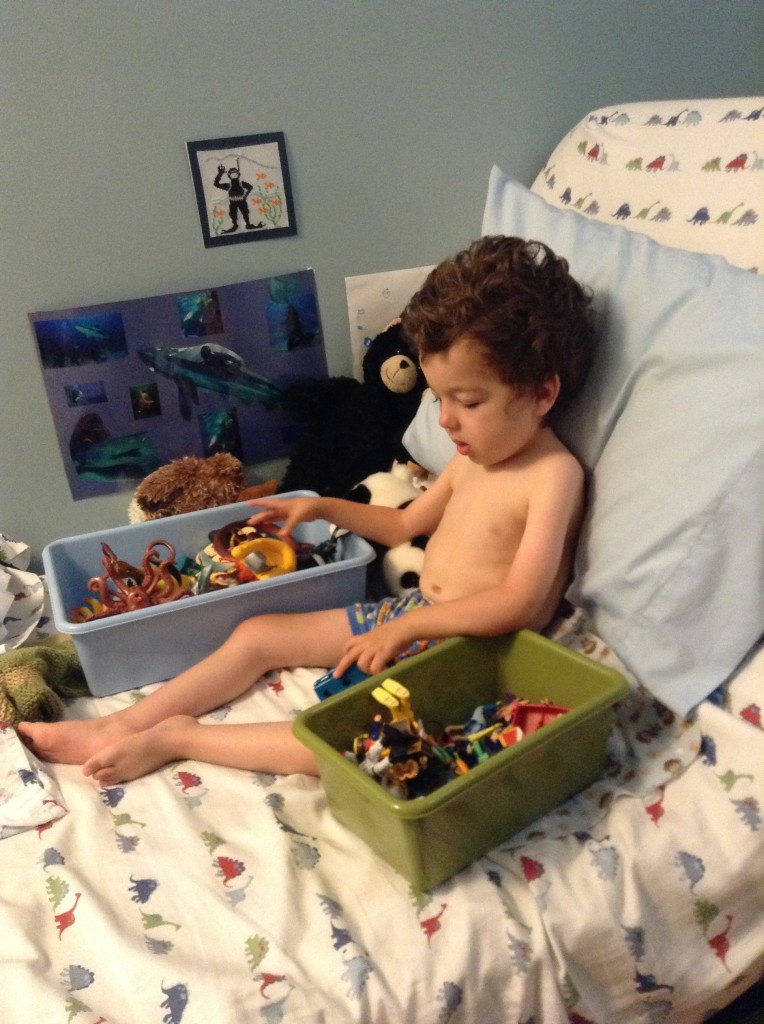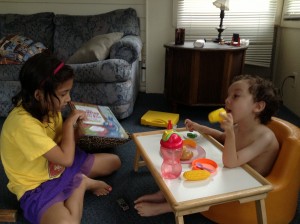SMA Awareness month has drawn to a close. What makes the day-to-day of raising a kid with SMA different from the day-to-day of raising a kid without SMA? Since I’ve never raised a kid without SMA, I might not be the best person to answer that question, but I’m going to try. Also, the range of needs of SMA kids varies, I can only clearly speak to Oscar’s day-to-day. Some families have a much more complicated situation, and others less complex. So here we go…
When Oscar wakes up in the morning he calls out to us to ask if he can wake up. If it’s not a school day, he likes to play in bed for awhile in the morning. His bed raises up so he can sit right in bed supported. There is a control that he can work himself to do this. We bring him whatever toys he is requesting that morning, though we often have to remind him that he needs to tell us all at once what he wants, rather than every three minutes requesting something new. Once he’s finished playing, we have to lift him out of bed to get his day started. Each time he needs to go to the bathroom we have to get his pants down, place him on the toilet, and stay with him the whole time. When he’s ready to sit at the kitchen table for breakfast (or drawing!) we transfer him to a high chair, not because his power chair can’t work at the table, but because the high chair is a little more compatible with the table.
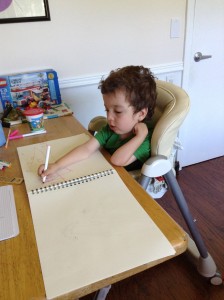 When Oscar wants to play with a friend, most often he goes in his bumbo chair with the tray.
When Oscar wants to play with a friend, most often he goes in his bumbo chair with the tray.
Because Oscar spends most of his day sitting, his muscles are tight, because they don’t move through a regular range of motion the way muscles of ambulatory people do. So, we have to stretch him, and a great way to do this is with knee immobilizer braces. The recommendation is for him to sleep in them so that he has an extended stretch, but we are not willing to mess with sleep right now, so we put them on him for extended reading or playing times on the couch.
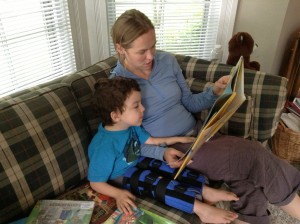 Oscar also needs to go in his stander daily. The recommended time is a minimum of two hours. That is very difficult to fit in. During preschool he was getting 45 minutes to an hour during school time. This might be reduced at kindergarten, since kindergarten is a busier schedule. We try to get him in it daily at home, but if he has PT, aqua therapy, or if we have plans it can be difficult to fit that time in.
Oscar also needs to go in his stander daily. The recommended time is a minimum of two hours. That is very difficult to fit in. During preschool he was getting 45 minutes to an hour during school time. This might be reduced at kindergarten, since kindergarten is a busier schedule. We try to get him in it daily at home, but if he has PT, aqua therapy, or if we have plans it can be difficult to fit that time in.
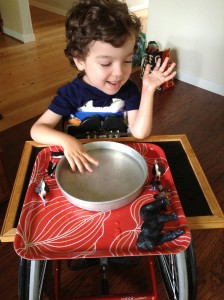 Oscar can still play in his stander, but he doesn’t have much independent movement. The stander is important for his bone development (as he bears weight in his stander), his respiratory health, and his digestive health.
Oscar can still play in his stander, but he doesn’t have much independent movement. The stander is important for his bone development (as he bears weight in his stander), his respiratory health, and his digestive health.
Oscar has a daily respiratory routine that he has to do, cough assist machine and nebulizer:
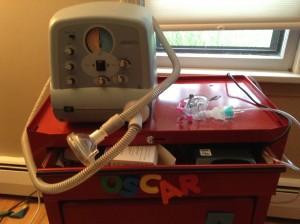 The two machines together take about 15-20 minutes. In the summer he has been able to do “the dance,” as we’ve taken to calling the respiratory routine, just once a day. Soon, as flu season comes back, he will need to do this twice a day. And any time he is sick, the frequency increases to approximately every two waking hours, with cough assist being done as often as needed (Oscar’s weak chest muscles don’t allow him to cough strongly enough to clear any secretions from his lungs).
The two machines together take about 15-20 minutes. In the summer he has been able to do “the dance,” as we’ve taken to calling the respiratory routine, just once a day. Soon, as flu season comes back, he will need to do this twice a day. And any time he is sick, the frequency increases to approximately every two waking hours, with cough assist being done as often as needed (Oscar’s weak chest muscles don’t allow him to cough strongly enough to clear any secretions from his lungs).
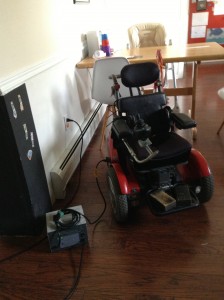 Once every two to three nights we have to remember to plug Oscar’s chair into the battery charger so he can still get around!
Once every two to three nights we have to remember to plug Oscar’s chair into the battery charger so he can still get around!
In addition to all the equipment, Oscar has physical therapy 4-6 times per week, depending on the week. About half of that happens at school, with the other half happening at our home or at CP Rochester in the therapy pool. He also has occupational therapy 2-3 times per week at school. All of the other meetings and appointments are spread out enough that I wouldn’t consider them part of the day-to-day, but I would say we (with him sometimes included) have around 30 meetings per year to go over his services and/or needs for school and home, and we have an average of maybe 20 or so doctor’s appointments per year, in a year without any major complications.
Despite all this, most of the time we just look at Oscar as a normal kid. He does all the things a typical almost 5-year old does, just in his own way.
Since it is SMA Awareness Month, we’ll ask again that you please consider sharing this blog post, and our web site with others. The more we raise awareness, the more thoughtful people can be about accessibility and acceptance.
